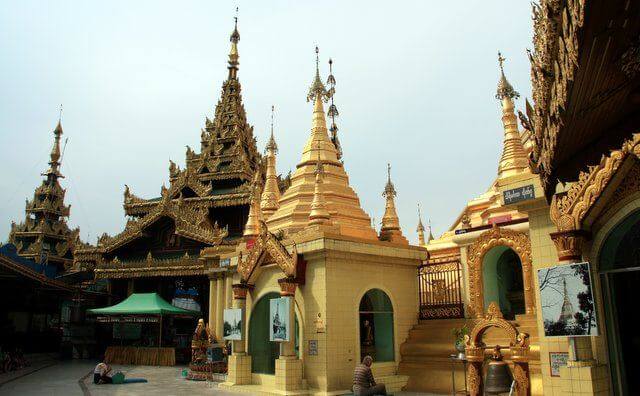
Inside the Sule Pagoda
Sparrows at Sule Padoga
After the sheer size, splendour and vibrancy of the Shwedagon Pagoda, the smaller and less ornate Sule Pagoda didn’t really stand a chance. Lying at a busy intersection in downtown Yangon, it’s noisy and surrounded by hawkers. After a brief look around we returned to the entrance to retrieve our shoes.
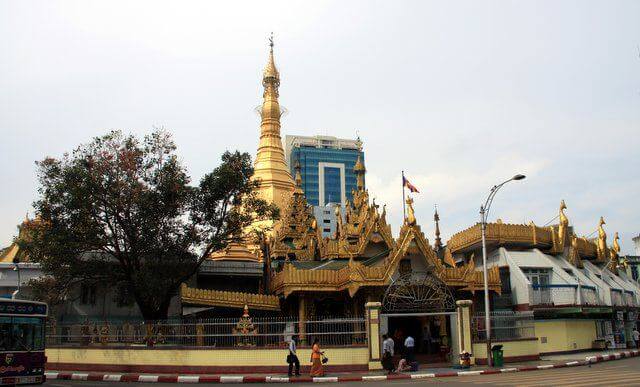
Sule Pagoda isn’t that attractive from the outside
Either side of the main entrance sat a number of ladies, each holding washing up bowls that were covered in netting and emitting a series of chirps. This is what I’d come here to see.
In order to earn merit with their Buddhist religion, many visitors purchase a captive sparrow and set it free. For a dollar, or 1000 kyats, you’re handed a small blue-billed sparrow and told to kiss its head before releasing it into the air.
Unlike so many of these potential scams, surprisingly the bird did actually fly away rather than loop round back to the seller.
Later at the waterfront market we saw the sparrow wholesalers, with a large mesh cart full of the tiny birds.
Given that it’s good Buddhist practice to release animals from captivity, surely those who capture and sell the sparrows aren’t doing much good for their prospects in the afterlife?
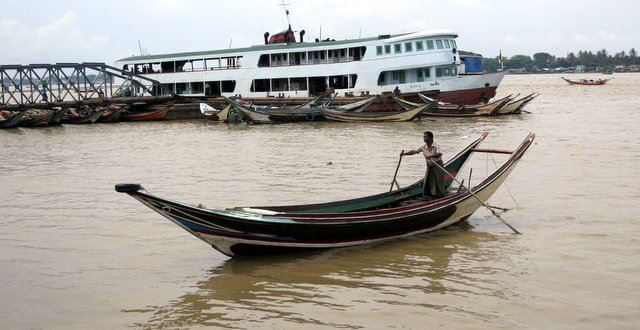
It may have been this chaps first day – he was rowing around in circles the whole time we were there.
Yangon River Bank
The strong smell of dried fish announced that we’d arrived at the river, long before we set eyes on the muddy waters.
A large market has grown up around Yangon’s dock area and where it reaches the banks it has even spread onto the ferries. The boats can take up to take 200 people and their watermelons across to the other side. During the journey they are captives to the numerous stalls that have set up on the boat selling hats and flowers. There are even fresh street food sellers if you need a snack during the ten minute journey, but beware the flocks of seagulls attracted to any morsel of food.
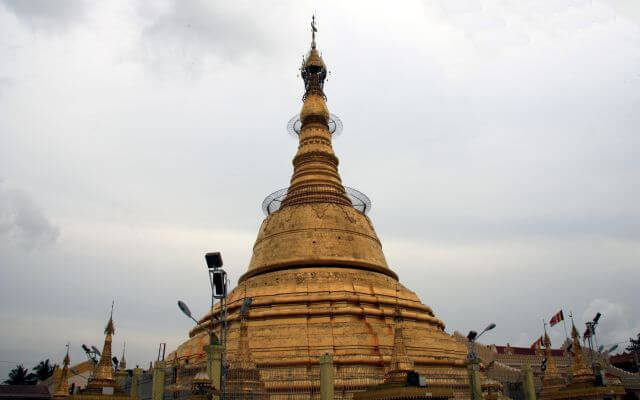
Botataung Pagoda Stupa
Botataung Pagoda
Deep within the market, just down from the sparrow wholesalers, is the Botataung Pagoda.
Bo-tataung means thousand-leaders and is named after the thousand military leaders who carried Buddhist relics from India over two thousand years ago. The pagoda was built around the same time as Sule Pagoda and Shwedagon Pagoda.
Originally called Kyaik-de-att, then Sandaw Shin, it contains a sacred hair of the Gautama Buddha.
Botataung was our first encounter with the military. This pagoda had a proper military checkpoint outside, complete with bunker and armed guard. Rather than the usual ticket seller, we had to give money directly to the government official. Not happy about this, I gave him my shoes to look after, which at 99% humidity is not a pleasant prospect.
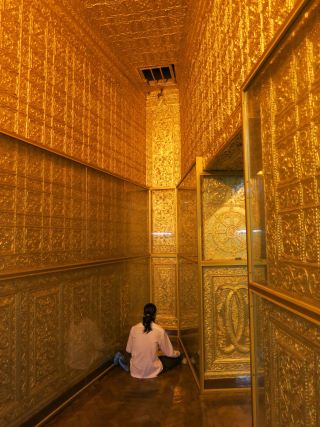
Gold Lined Passages at the Botataung Pagoda
Side note: It’s a good idea to wear slip on shoes or flip flops when doing anything touristy in Myanmar as shoes can come on and off dozens of times a day – any time you enter a home, a temple, a shop or a stupa they usually require bare feet.
The pagoda itself is impressive, but the real draw is the passageway leading to the sacred hair. Shaped like a star and completely lined with gold, the passage leads visitors through a number of ancient pictorial tales to the relic chamber.
Unlike China, everyone here queued respectfully, waiting for their chance to see the hair. I didn’t want to make the queue any longer for those who had walked here from all over the country on a pilgrimage, so after a brief spell reminiscing about civilised English queuing got out of their way and went outside.
Back at the pagoda we were accosted by a monk. With his unkempt ear and nose hair and German accent he initially looked a little aggressive, but turned out just to be passionate. He spoke for a long time about David Cameron and EU politics, George Bush Senior and his questionable American military policies and the remaining problems with the Burmese Government. He was very adamant that the country still be called Burma, rather than the regimes choice of Myanmar.
I suspect he may be the reason for the military checkpoint outside. They’re not keeping people out, they’re keeping him inside.
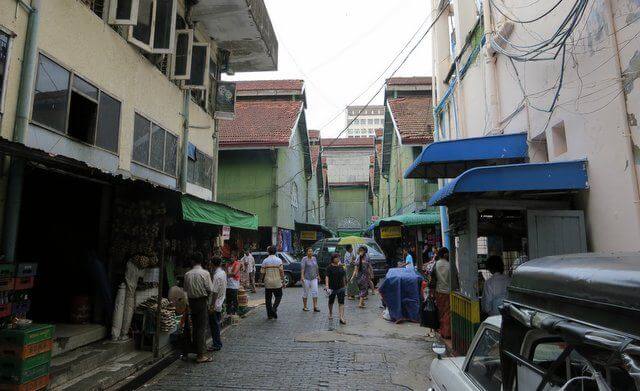
Bogyoke Market
Bogyoke Market
This crumbling colonial market used to be known as Scott’s Market, but is now the main destination for tourists looking for souvenirs.
The whole front of the building is lined with jade shops, but past these the more traditional market still exists. Cobbled streets lead to umbrella shops, teak carvers and the ever present street food stalls, all competing for passing trade.
As I’d suspected, we were here mostly to buy jade. We arrived around lunch time and most of the jade shops ignored us and continued with their instant noodles. Those that did stop eating offered a 50% discount as soon as we got through the door. This was still negotiable and after much deliberation we only paid about 30% of the ticket price.
I was never a fan of jade, but it seems I’d never seen the good quality items. Most of the shops sold jade carved into pale green beads, rings and Buddha’s for a few hundred dollars, but one had a display of simple polished stones. At first glance these looked to be plain and presumably cheap, but getting closer the jade seemed to glow from within and I was rather taken with them.
On asking the price, a small pendant was $45,000. Some of the other pieces were much, much larger.
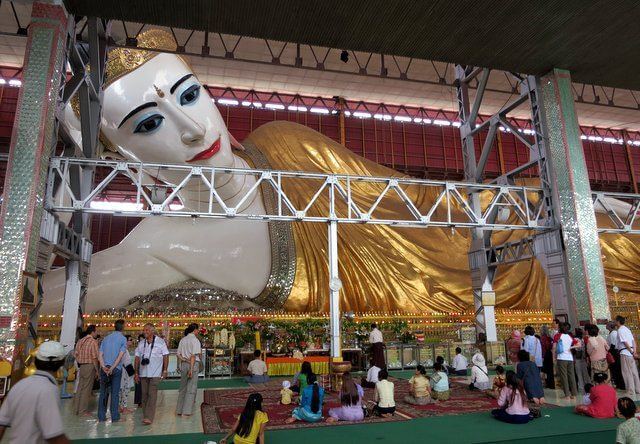
The tin shed surrounding the Buddha doesn’t lend itself to full length photography
ChaukHtatGyi Reclining Buddha
Our last stop of the day coincided with the beginning of the rains. Chaukhtatgyee is a 216 ft long and 60ft high Buddha built in 1907 by a single benefactor named U Hpo Tha.
The Buddha has a crown on its head is studded with diamonds and other gems, and the feet are marked with symbols representing the Buddha’s 150 past lives.
There was probably a lot more to learn, but the torrential rain falling on the tin roof made any further conversation impossible.
We returned to the hotel to grab a sundowner. Taking our cue from the statue at Chaukhtatgyi, we reclined on the patio, bedecked in our new jewels, and watched the recently freed sparrows fly around Kandawgyi Lake as the Shwedagon Pagoda lit up in the background.
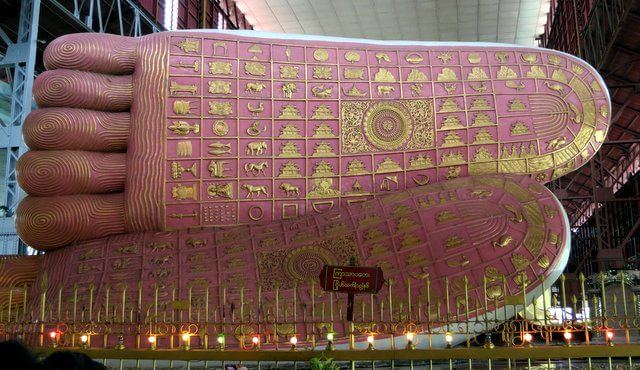
The feet of the ChaukHtatGyi Reclining Buddha, with symbols representing his past lives.
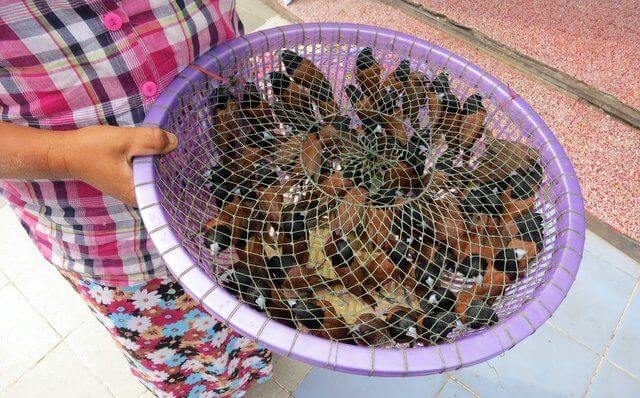






Pingback: @1Dad1Kid
Pingback: @WanderingEds
Buddha didn’t say or teach anything like that I mean “releasing sparrow”. It’s just some uneducated people doing it in easy way. And it’s not all the people in Myanmar believe and do this kind of act.
We, nowadays, younger generations didn’t really encourage to do that act.
It was nice reading your posts about Myanmar. I love them. But this post title is a little bit misleading to the readers.